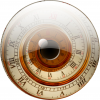One of my customers asked me to create 9 posters - each 700*1000 mm. I had used a Nikon Coolpix 990 digital camera to take some photos of their products. The posters was intended to use as indidual posters, and as a colection/collage.
First I prepared the photos in Paint Shop Pro, and saved them as Tiffs (originals was jpeg).
I also wanted to use some photos of stones as a background. Because of the width of the collection, I created a panorama from three photos, and used Xara to make this, and exported the panorama as a big TIFF, and sliced it to three parts in PSP.
Then I created three Xara files with three independent 700*1000 mm rectangles, and imported one of the sliced image to each Xara document. Then I used the fill tool to create the bitmap-background from each of the three sliced images. The fill is centered in the middle rectangle an was dragged to cover the background of the three rectangles. I also coverd the bakground with a grey rectangle, and used the transparent tool to soften the colors of the background. I did the same with the next to Xara documents - so I had 9 posters as a big panorama - width is about 6,5 meters.
Then I imported the photos of the products, and placed them at the same position in each poster, and put some text and the logo, which was created in Xara.
When finished, I exported each poster as an independent RGB Tiff with 200 dpi. I thought this would make a crisp text/logo.
At the printoffice, they imported the the TIFFs to Photoshop and created photoshop-eps. I got the posters today, and both me and the printoffice was very satisfied. The customer will get them tomorrow - I look forward to bring them.
http://home.online.no/~oystange/montering.jpg
Øystein
http://www.heimesider.com



 Reply With Quote
Reply With Quote



Bookmarks